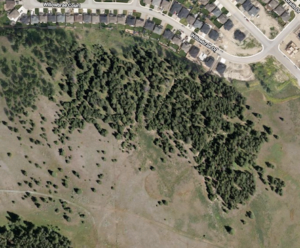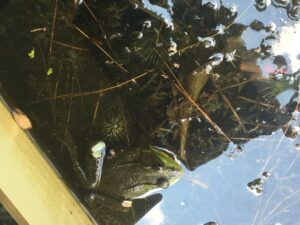Sampling Using Virtual Forests (Mohn Mill – Sampling by Area)
Compare the results. Which technique is the most efficient in terms of time spent sampling? Compare the actual densities with the estimated (data) densities from your sampling. Calculate the percentage error for the different sampling techniques for both common and rare species. What was the most accurate sampling strategy for common species? What was the most accurate for rare species? Did the accuracy stay the same or decline for rare species? Was 24 a sufficient number of sample points to capture the number of species in this community? Was it enough sample points to accurately estimate the abundance of these species?
- Which technique is the most efficient in terms of time spent sampling?
Time Spent Sampling:
Area Haphazard (t= 12:45, m=765)
Area Random (t=12:09, m=729)
Area Systematic (t=12:44, m=764)
In terms of time spent sampling area, random sampling was the most efficient by approximately 9.5% compared to both haphazard and systematic sampling which differed by only 1 minute.
- Calculate the percentage error for the different sampling techniques for both common and rare species:
Red Maple Density
Actual (403.7); Area Haphazard Data (337.5) – Percentage Error= 16.4%
Actual (403.7); Area Random (425.0) – Percentage Error= 5.3%
Actual (403.7); Area Systematic Data (445.8) – Percentage Error= 10.4%
White Oak Density
Actual (74.5); Area Haphazard Data (41.7) – Percentage Error= 44%
Actual (74.5); Area Random Data (54.2) – Percentage Error= 27.24%
Actual (74.5); Area Systematic Data (125.0) – Percentage Error= 67.78%
Chestnut Oak Density
Actual (82.9); Area Haphazard Data (54.2) – Percentage Error= 34.62%
Actual (82.9); Area Random Data (91.7) – Percentage Error= 10.62%
Actual (82.9); Area Systematic Data (41.7) – Percentage Error= 49.69%
Witch Hazel Density
Actual (142.4); Area Haphazard Data (191.7) – Percentage Error= 34.62%
Actual (142.4); Area Random Data (166.7) – Percentage Error= 17.06%
Actual (142.4); Area Systematic Data (150.0) – Percentage Error= 5.33%
Red/Black Oak Density
Actual (46.7); Area Haphazard Data (29.2) – Percentage Error= 37.47%
Actual (46.7); Area Random Data (58.3) – Percentage Error= 24.84%
Actual (46.7); Area Systematic Data (0.0) – Percentage Error= 100%
Eastern Hemlock Density
Actual (45.6); Area Haphazard Data (8.3) – Percentage Error= 81.8%
Actual (45.6); Area Random Data (62.5) – Percentage Error= 37.06%
Actual (45.6); Area Systematic Data (41.7) – Percentage Error= 8.55%
Black Tupelo Density
Actual (35.5); Area Haphazard Data (33.3) – Percentage Error= 6.2%
Actual (35.5); Area Random Data (0.0) – Percentage Error= 100%
Actual (35.5); Area Systematic Data (33.3) – Percentage Error= 6.2%
White Pine Density
Actual (12.8); Area Haphazard Data (4.2) – Percentage Error= 67.2%
Actual (12.8); Area Random Data (12.5) – Percentage Error= 2.34%
Actual (12.8); Area Systematic Data (12.5) – Percentage Error= 2.34%
Downy Juneberry Density
Actual (9.9); Area Haphazard Data (8.3) – Percentage Error= 16.16%
Actual (9.9); Area Random Data (12.5) – Percentage Error= 26.26%
Actual (9.9); Area Systematic Data (16.7) – Percentage Error= 68.68%
Striped Maple Density
Actual (13.6); Area Haphazard Data (0.0) – Percentage Error= 100%
Actual (13.6); Area Random Data (4.2) – Percentage Error= 69.12%
Actual (13.6); Area Systematic Data (0.0) – Percentage Error= 100%
Hawthorn Density
Actual (4.5); Area Haphazard Data (0.0) – Percentage Error= 100%
Actual (4.5); Area Random Data (0.0) – Percentage Error= 100%
Actual (4.5); Area Systematic Data (4.2) – Percentage Error= 6.6%
Black Cherry Density
Actual (1.5); Area Haphazard Data (0.0) – Percentage Error= 100%
Actual (1.5); Area Random Data (0.0) – Percentage Error= 100%
Actual (1.5); Area Systematic Data (0.0) – Percentage Error=100%
Sweet Birch Density
Actual (1.2); Area Haphazard Data (0.0) – Percentage Error= 100%
Actual (1.2); Area Random Data (4.0) – Percentage Error= 233%
Actual (1.2); Area Systematic Data (0.0) – Percentage Error= 100%
American Basswood Density
Actual (1.5); Area Haphazard (0.0) – Percentage Error= 100%
Actual (1.5); Area Random Data (0.0) – Percentage Error= 100%
Actual (1.5); Area Systematic Data (0.0) – Percentage Error= 100%
Yellow Birch Density
Actual (0.8); Area Haphazard Data (0.0) – Percentage Error= 100%
Actual (0.8); Area Random Data (4.2) – Percentage Error= 425%
Actual (0.8); Area Systematic Data (16.7) – Percentage Error= 1987.5%
White Ash Density
Actual (0.8); Area Haphazard Data (0.0) – Percentage Error= (0.0-0.8)/0.8*100= 100%
Actual (0.8); Area Random Data (0.0) – Percentage Error= (0.0-0.8)/0.8*100= 100%
Actual (0.8); Area Systematic Data (0.0) – Percentage Error= (0.0-0.8)/0.8*100= 100%
- What was the most accurate sampling strategy for common species?
The most accurate sampling strategy for common species overall tended to be random sampling.
- What was the most accurate for rare species?
All the sampling methods were relatively poor for rare species, either missing them entirely or grossly overrepresenting them. For example, both White Ash and American Basswood were missed entirely regardless of sampling method with consistent percent error of 100%. Similarly, a mixture of missing entirely and grossly overestimating density was observed for both Yellow Birch and Sweet Birch, regardless of sampling method.
- Did the accuracy stay the same or decline for rare species?
Accuracy for rare species declined drastically in almost all cases.
- Was 24 a sufficient number of sample points to capture the number of species in this community?
Overall no, 24 was not a enough sample points to capture the number of species in this community. Based on the analyses, using the sampling methods employed here with 24 sample points, I would have entirely missed White Ash, American Basswood and Black Cherry.
- Was it enough sample points to accurately estimate the abundance of these species?
Overall no, some species were very accurately measured with some sampling methods with 24 sample points while others were very inaccurately measured.





